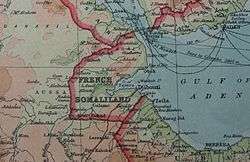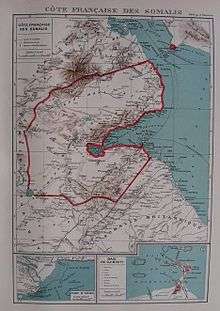French Somaliland
| French Somaliland | ||||||||
| Côte Française des Somalis Dhulka Soomaaliyeed ee Faransiiska | ||||||||
| Colony (1896-1946) Overseas territory (1946-1967) | ||||||||
| ||||||||
| Anthem La Marseillaise • Djibouti (instrumental only) | ||||||||
 French Somaliland in 1922 | ||||||||
| Capital | Djibouti | |||||||
| Languages | French, Somali, Afar, Arabic | |||||||
| Religion | Christianity, Islam | |||||||
| Demonym | Somali French Somali | |||||||
| Government | Dependent territory | |||||||
| Governor | ||||||||
| • | 1896–1899 | Léonce Lagarde | ||||||
| • | 1966–1967 | Louis Saget | ||||||
| Historical era | New Imperialism | |||||||
| • | Established | May 20, 1896 | ||||||
| • | Italian invasion | June 18, 1940 | ||||||
| • | British occupation | December 28, 1942 | ||||||
| • | Status changed to overseas territory | October 27, 1946 | ||||||
| • | Renamed | July 5, 1967 | ||||||
| Area | ||||||||
| • | 1963 | 23,200 km² (8,958 sq mi) | ||||||
| Population | ||||||||
| • | 1963 est. | 165,000 | ||||||
| Density | 7.1 /km² (18.4 /sq mi) | |||||||
| Currency | French franc (1896–1949) French Somaliland franc (1949–1967) | |||||||
| ||||||||
| Today part of | | |||||||
Part of a series on the |
|---|
| History of Djibouti |
 |
| Antiquity |
| Middle Ages |
| Colonial period |
| Modern period |
| Republic of Djibouti |
|
|
French Somaliland (French: Côte française des Somalis, lit. "French Coast of Somalis"; Somali: Dhulka Soomaaliyeed ee Faransiiska) was a French colony in the Horn of Africa. It existed between 1883 and 1967.
History
It was established between 1883 and 1887, after the ruling Somali and Afar sultans signed the land away in various treaties with the French.[1][2][3]

On the other side of the Bab el Mandeb strait, the French held a small peninsula in the Aden territory.
The construction of the Imperial Ethiopian Railway west into Ethiopia turned the port of Djibouti into a boomtown of 15,000[4] at a time when Harar was the only city in Ethiopia to exceed that.[5]
Although the population fell after the completion of the line to Dire Dawa and the original company failed and required a government bail-out, the rail link allowed the territory to quickly supersede the caravan-based trade carried on at Zeila[6] (then in the British area of Somaliland) and become the premier port for coffee and other goods leaving southern Ethiopia and the Ogaden through Harar.
The railway continued to operate following the Italian conquest of Ethiopia but, following the tumult of the Second World War, the area became an overseas territory of France in 1946. In 1967, French Somaliland was renamed the French Territory of the Afars and the Issas and, in 1977, it became the independent country of Djibouti.
See also
- List of colonial heads of French Somaliland
- List of French possessions and colonies
- French colonial empire
References
- ↑ Hugh Chisholm (ed.) The Encyclopædia Britannica 11th ed., Vol. 25, p. 383. 1911.
- ↑ Raph Uwechue, Africa year book and who's who, (Africa Journal Ltd.: 1977), p. 209 ISBN 0903274051.
- ↑ A Political Chronology of Africa, (Taylor & Francis: 2001), p. 132 ISBN 1857431162.
- ↑ "Jibuti" [i.e., Djibouti] in the Encyclopædia Britannica 11th ed., Vol. 15. 1911.
- ↑ "Abyssinia" [i.e., Ethiopia] in the Encyclopædia Britannica 11th ed, Vol. 1. 1911.
- ↑ "Zaila" [i.e., Zeila] in the Encyclopædia Britannica 11th ed., Vol. 28. 1911.
Bibliography
- Imbert-Vier, Simon (2008). Frontières et limites à Djibouti durant la période coloniale (1884–1977) (PhD thesis). Université de Provence–Aix-Marseille I.
Coordinates: 11°36′N 43°10′E / 11.600°N 43.167°E

